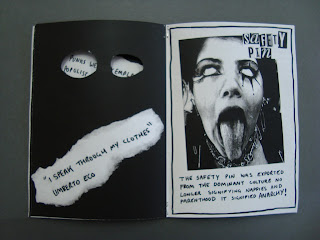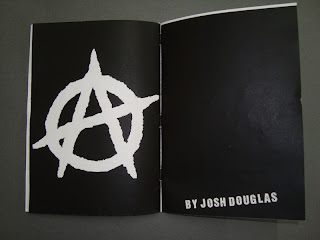1. What skills have you developed through this module and how effectively do you think you have applied them?
From this module I feel I have a better understanding of design. Although I am not the best at wording things I definitely find it easier to analyse work. The DIET evaluation method has helped to identify problems or issues with my work this is a useful method which I will continue to use. This module has helped me pick up a book for the first time in years which I think is a wonderful thing. Before this course I hadn't read a book for years and found it quite difficult to read. As a result of this I feel more confident with my reading. I chose a fairly hard book which took me ages to read and I found myself researching lots of words but afterwards I felt I had accomplished something.
2. What approaches to/methods of design production have you devloped and how have they informed your design development process?
For the publication I found my main method of design was trial and error. I spent allot of time scanning and cutting up lettering and rewording and writing. It took me at least 5 mock up books until I came to my final result, as I created each one I kept identifying things that needed changing or improving so I had to rescan aspects of my design. This process has helped me develop my practice and has also informed me that planning is essential, I found I have spent the last week running on 2 hours sleep a day as I was staying up all night making corrections and changing my design to get something I was really happy with. If I had left a bit more time for my publication I could of avoided this problem. The crits were also a useful process I took on board the comments from the final crit and went away and made my amendments and I feel this has really benefited the Zine greatly. I found most of the lectures particularly useful too, the communication lectures in particular gave me a starting point for my publication
3. What strengths can you identify in your work and how/will you capitalize on these?
One of my strengths for this project I feel was the fact I tried something new. I have never done collaging before or used the scanner for design. Although the process took twice as long I had a lot more fun and really enjoyed creating my publication. I tried to have a mix of media , using hand drawn images, text, photos, and digital type. This module has taught me to not stick to what you know but experiment and try something new. I am still trying to find what truly interests me within graphic design but I wont find out until I keep experimenting. another strength is the fact I revisited my publication adding new design elements like the cut out sections and extra quotes taking it that extra mile, I have learnt you can never do enough, there is always more you could do to improve your work.
4. What weaknesses can you identify in your work and how will you address these in the future?
I feel my essay has let this module down. I find it quite difficult to get my thoughts down on paper in a intelligent mannar. My essay style was very conversational and I found it difficult to structure my essay in a way that flows and makes sense. This can only improve with practice and I think reading could help me too, I think I could of done with some more quotes too to back up my argument. In terms of my publication, I think the content I wrote could of been worded better as it does not sound that intelligent but I suppose it kind of compliments the punk DIY image intended. I think my design process could of included more development work and design sheets, it feels like I have done masses of work but on paper not that much, I think because most of the time was spent scanning and writing it doesn't look that much even though I spent ages doing it all. I will definitely get all my ideas down on paper from now on even if they are rough or unfinished, it will all help to outline how I have got to my final outcome.
5. Identify five things that you will do differently next time and what do you expect to gain from doing these?
- Plan time better - I have probably said this for every evaluation but it has definitely been an issue all year. I think I am gonna start staying an extra hour every night after college in order to stay on top of my work.
- Read More - From this module I have learnt reading is essential. It helps build vocabulary and will also help me to analyse work in a more professional manner
- Research more into lectures - I feel I could of done some extended research on lecture themes this will help my overall practice so I know whats out there in the world.
- Experiment - with different media, although I tried a few different things, there are other processes I am still wanting to try.
- Use the library more - This module has made me realise the importance of the library. It is a very valuable source that I should not take for granted.
6. How would you grade yourself on the following areas:
Attendance : 5
Punctuality : 5
Motivation : 4
Commitment : 4
Quality : 4
Quantity : 3
Contribution to the group : 4
Contribution to the group : 4






































